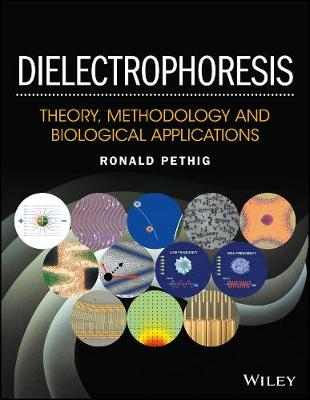
Dielectrophoresis
John Wiley & Sons Inc (Verlag)
978-1-118-67145-0 (ISBN)
Comprehensive coverage of the basic theoretical concepts and applications of dielectrophoresis from a world-renowned expert.
Features hot application topics including: Diagnostics, Cell-based Drug Discovery, Sensors for Biomedical Applications, Characterisation and Sorting of Stem Cells, Separation of Cancer Cells from Blood and Environmental Monitoring
Focuses on those aspects of the theory and practice of dielectrophoresis concerned with characterizing and manipulating cells and other bioparticles such as bacteria, viruses, proteins and nucleic acids.
Features the relevant chemical and biological concepts for those working in physics and engineering
Ronald Pethig Emeritus Professor of Bioelectronics, The University of Edinburgh, UK
Index of Worked Examples xi
Preface xiii
Nomenclature xvii
1 Placing Dielectrophoresis into Context as a Particle Manipulator 1
1.1 Introduction 1
1.2 Characteristics of Micro-Scale Physics 2
1.3 Microfluidic Manipulation and Separation of Particles 3
1.4 Candidate Forces for Microfluidic Applications 4
1.5 Combining Dielectrophoresis with other Forces 25
1.6 Summary 26
1.7 References 27
2 How does Dielectrophoresis Differ from Electrophoresis? 31
2.1 Introduction 31
2.2 Electric Field 32
2.3 Electrophoresis 33
2.4 Induced Surface Charge and Dipole Moment 38
2.5 Dielectrophoresis 40
2.6 Summary 46
2.7 References 47
3 Electric Charges, Fields, Fluxes and Induced Polarization 49
3.1 Introduction 49
3.2 Charges and Fields 50
3.3 Gauss’s Law 61
3.4 Induced Dielectric Polarization 71
3.5 Capacitance 73
3.6 DivergenceTheorem and Charge Density Relaxation Time 74
3.7 Summary 75
3.8 References 76
4 Electrical Potential Energy and Electric Potential 77
4.1 Introduction 77
4.2 Electrical Potential Energy 77
4.3 Electrical Potential 81
4.4 Electrostatic Field Energy 87
4.5 Summary 89
4.6 References 91
5 Potential Gradient, Field and Field Gradient; Image Charges and Boundaries 93
5.1 Introduction 93
5.2 Potential Gradient and Electrical Field 93
5.3 Applying Laplace’s Equation 96
5.4 Method of Image Charges 110
5.5 Electric Field Gradient 112
5.6 Electrical Conditions at Dielectric Boundaries 114
5.7 Summary 116
5.8 References 117
6 The Clausius–Mossotti Factor 119
6.1 Introduction 119
6.2 Development of the Clausius–Mossotti–Lorentz Relation 121
6.3 Refinements of the Clausius–Mossotti–Lorentz Relation 131
6.4 The Complex Clausius–Mossotti Factor 134
6.5 Summary 141
6.6 References 143
7 Dielectric Polarization 145
7.1 Introduction 145
7.2 Electrical Polarization at the Atomic and Molecular Levels 145
7.3 Dipole Relaxation and Energy Loss 153
7.4 Interfacial Polarization 159
7.5 Summary 164
7.6 References 165
8 Dielectric Properties ofWater, Electrolytes, Sugars, Amino Acids, Proteins and Nucleic Acids 167
8.1 Introduction 167
8.2 Water 167
8.3 Electrolyte Solutions 172
8.4 Amino Acids and Proteins in Solution 179
8.5 Nucleic Acids 194
8.6 Summary 204
8.7 References 206
9 Dielectric Properties of Cells 213
9.1 Introduction 213
9.2 Cells: A Basic Description 213
9.3 Electrical Properties of Cells 214
9.4 Modelling the Dielectric Properties of Cells 222
9.5 Effect of Cell Surface Charge on Maxwell–Wagner Relaxation 233
9.6 Dielectric Properties of Bacteria 236
9.7 Summary 239
9.8 References 241
10 Dielectrophoresis: Theoretical and Practical Considerations 245
10.1 Introduction 245
10.2 Inherent Approximations in the DEP Force Equation 245
10.3 Refinements of the DEP Force Equation 249
10.4 Electrodes: Fabrication, Materials and Modelling 281
10.5 The Second (High-Frequency) DEP Crossover Frequency (fxo2) 296
10.6 Summary 298
10.7 References 300
11 Dielectrophoretic Studies of Bioparticles 309
11.1 Introduction 309
11.2 DEP Characterization and Separation of Live and Dead Cells 309
11.3 Mammalian Cells 332
11.4 Bacteria 345
11.5 Other Cell Types (Plant, Algae, Oocytes, Oocysts) andWorms 347
11.6 Virions 351
11.7 Nucleic Acids and Proteins 356
11.8 Summary 369
11.9 References 370
12 Microfluidic Concepts of Relevance to Dielectrophoresis 381
12.1 Introduction 381
12.2 Gases and Liquids 381
12.3 Fluids Treated as a Continuum 384
12.4 Basic Fluid Statics and Fluid Dynamics 385
12.5 Navier–Stokes Equations 392
12.6 Diffusion 394
12.7 Ionic (Electrical) Double Layer 397
12.8 Electro-osmosis 400
12.9 Summary 403
12.10 References 404
Appendices 405
A Values of Fundamental Physical Constants 405
B SIPrefixes 405
C The Base Quantities in the SI System of Units 405
D Derived Physical Quantities, their Defining Equation or Law and Dimensions 405
E Diffusion Coefficients for Molecules and Ions inWater at 298 K 406
F Diffusion Coefficients for Bio-Particles inWater at 293 K 406
G Viscosity and Surface Tension Values for Liquids at 293 K 406
H Activity Coefficients for Common Compounds that Dissociate into Ions in Solution 406
I Electrical Mobility of Ions at 25 ◦C in Dilute Aqueous Solution 406
J Buffering Systems and their pH Buffering Range 406
K Composition of 1 μL of Human Blood 407
L Blood Cells, Platelets and Some Pathogenic Bioparticles 407
Author Index 411
Subject Index 423
| Erscheinungsdatum | 07.05.2017 |
|---|---|
| Verlagsort | New York |
| Sprache | englisch |
| Maße | 216 x 282 mm |
| Gewicht | 1157 g |
| Themenwelt | Naturwissenschaften ► Chemie |
| Technik ► Umwelttechnik / Biotechnologie | |
| ISBN-10 | 1-118-67145-7 / 1118671457 |
| ISBN-13 | 978-1-118-67145-0 / 9781118671450 |
| Zustand | Neuware |
| Haben Sie eine Frage zum Produkt? |
aus dem Bereich


